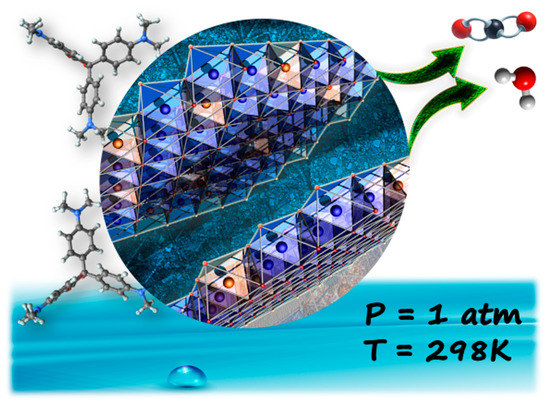Influence of the Active Phase (Fe, Ni, and Ni–Fe) of Mixed Oxides in CWAO of Crystal Violet
Abstract
1. Introduction
2. Results
2.1. Characterization
2.2. Catalytic Activity
3. Discussion
Selectivity in CV Reaction
4. Materials and Methods
4.1. Catalyst Synthesis
4.2. Characterization
4.3. Catalytic Evaluation
5. Conclusions
Author Contributions
Funding
Acknowledgments
Conflicts of Interest
References
- Vallet, A.; Ovejero, G.; Rodríguez, A.; Peres, J.A.; García, J. Ni/MgAlO regeneration for catalytic wet air oxidation of an azo-dye in a trickle-bed reactor. J. Hazard. Mater. 2013, 244–245, 46–53. [Google Scholar] [CrossRef] [PubMed]
- Sahoo, C.; Gupta, A.K.; Pal, A. Photocatalytic degradation of Crystal Violet (C.I. Basic Violet 3) on silver ion doped TiO2. Dye. Pigment. 2005, 66, 189–196. [Google Scholar] [CrossRef]
- Xu, Y.; Chen, X.; Li, Y.; Ge, F.; Zhu, R. Quantitative structure–property relationship (QSPR) study for the degradation of dye wastewater by Mo–Zn–Al–O catalyst. J. Mol. Liq. 2016, 215, 461–466. [Google Scholar] [CrossRef]
- Elkady, M.F.; Ibrahim, A.M.; Abd El-Latif, M.M. Assessment of the adsorption kinetics, equilibrium and thermodynamic for the potential removal of reactive red dye using eggshell biocomposite beads. Desalination 2011, 278, 412–423. [Google Scholar] [CrossRef]
- Zhang, W.; Li, H.J.; Kan, X.W.; Dong, L.; Yan, H.; Jiang, Z.W.; Yang, H. Adsorption of anionic dyes fromaqueous solutions using chemicallymodified straw. Bioresour. Technol. 2012, 117, 40–47. [Google Scholar] [CrossRef]
- Zhang, Y.; Zhang, Z.; Yan, Q.; Wang, Q. Synthesis, characterization, and catalytic activity of alkali metalmolybdate/α-MoO3 hybrids as highly efficient catalytic wet airoxidation catalysts. Appl. Catal. A Gen. 2016, 511, 47–58. [Google Scholar] [CrossRef]
- Chaibakhsh, N.; Ahmadi, N.; Zanjanchi, M.A. Use of Plantago major L. as a natural coagulant for optimized decolorization of dye-containing wastewater. Ind. Crops Prod. 2014, 61, 169–175. [Google Scholar] [CrossRef]
- Liang, C.Z.; Sun, S.P.; Li, F.Y.; Ong, Y.K.; Chung, T.S. Treatment of highly concentrated wastewater containing multiple synthetic dyes by a combined process of coagulation/flocculation and nanofiltration. J. Membr. Sci. 2014, 469, 306–315. [Google Scholar] [CrossRef]
- Yuan, M.J.; Wang, S.T.; Wang, X.H.; Zhao, L.L.; Hao, T.H. Removal of organic dye by air and macroporous ZnO/MoO3/SiO2 hybrid under room conditions. Appl. Surf. Sci. 2011, 257, 7913–7919. [Google Scholar] [CrossRef]
- Vakili, M.; Rafatullah, M.; Salamatinia, B.; Abdullah, A.Z.; Ibrahim, M.H.; Tan, K.B.; Gholami, Z.; Amouzgar, P. Application of chitosan and its derivatives as adsorbents for dye removal from water and wastewater: A review. Carbohydr. Polym. 2014, 113, 115–130. [Google Scholar] [CrossRef]
- Au, W.; Parhak, S.; Collie, C.J.; Hsu, T.C. Cytogenetic Toxicity of Gentian Violet and Crystal Violet on Mammalian Cells In Vitro. Mutat. Res. 1978, 58, 269–276. [Google Scholar] [CrossRef]
- Rai, P.; Gautam, R.K.; Banerjee, S.; Rawat, V.; Chattopadhyaya, M.C. Synthesis and characterization of a novel SnFe2O4@activated carbon magnetic a nocomposite and its effectiveness in the removal of crystal violet from aqueous solution. J. Environ. Chem. Eng. 2015, 3, 2281–2291. [Google Scholar] [CrossRef]
- Nezamzadeh-Ejhieh, A.; Banan, Z. Sunlight assisted photodecolorization of crystal violet catalyzed by CdS nanoparticles embedded on zeolite A. Desalination 2012, 284, 157–166. [Google Scholar] [CrossRef]
- Lellis, B.; Fávaro-Polonio, C.Z.; Pamphile, J.A.; Polonio, J.C. Effects of textile dyes on health and the environment and bioremediation potential of living organisms. Biotechnol. Res. Innov. 2019, 3, 275–290. [Google Scholar] [CrossRef]
- Gupta, A.K.; Pal, A.; Sahoo, C. Photocatalytic degradation of a mixture of crystal violet (basic violet 3) and methyl red dye in aqueous suspensions using Ag+ doped TiO2. Dyes Pigment. 2006, 69, 224–232. [Google Scholar] [CrossRef]
- Yin, J.; Cai, J.; Yin, C.; Gao, L.; Zhou, J. Degradation performance of crystal violet over CuO@AC and CeO2-CuO@AC catalysts using microwave catalytic oxidation degradation method. J. Environ. Chem. Eng. 2016, 4, 958–964. [Google Scholar] [CrossRef]
- Chen, Q.; Yu, P.; Huang, W.; Yu, S.; Liu, M.; Gao, C. High-flux composite hollow fiber nanofiltration membranes fabricated through layer-by-layer deposition of oppositely charged crosslinked polyelectrolytes for dye removal. J. Membr. Sci. 2015, 492, 312–321. [Google Scholar] [CrossRef]
- Reddy, K.R.; Hassan, M.; Gomes, V.G. Hybrid nanostructures based on titanium dioxide for enhanced photocatalysis. Appl. Catal. A Gen. 2015, 489, 1–16. [Google Scholar] [CrossRef]
- Reddy, K.R.; Nakata, K.; Ochiai, T.; Murakami, T.; Taketoshi, D.A.; Fujishima, A. Nanofibrous TiO2-core/conjugated polymer-sheath composites: Synthesis, structural properties and photocatalytic activity. J. Nanosci. Nanotechnol. 2010, 10, 7951–7957. [Google Scholar] [CrossRef]
- Vijayalakshmidevi, S.R.; Muthukumar, K. Improved biodegradation of textile dye effluent by coculture. Ecotox. Env. Saf. 2015, 114, 23–30. [Google Scholar] [CrossRef]
- Kebria, M.R.S.; Jahanshahi, M.; Rahimpour, A. SiO2 modified polyethyleneimine—Based nanofiltration membranes for dye removal from aqueous and organic solutions. Desalination 2015, 367, 255–264. [Google Scholar] [CrossRef]
- Rondon, H.; El-Cheikh, W.; Boluarte, I.A.R.; Chang, C.Y.; Bagshaw, S.; Farago, L. Application of enhanced membrane bioreactor (eMBR) to treat dye wastewater. Bioresour. Technol. 2015, 183, 78–85. [Google Scholar] [CrossRef] [PubMed]
- Punzi, M.; Anbalagan, A.; Börner, R.A.; Svensson, B.M.; Jonstrup, M.; Mattiasson, B. Degradation of a textile azo dye using biological treatment followed by photo—Fenton oxidation: Evaluation of toxicity and microbial community structure. Chem. Eng. J. 2015, 270, 290–299. [Google Scholar] [CrossRef]
- Vaiano, V.; Sacco, O.; Sannino, D.; Ciambelli, P. Nanostructured N-doped TiO2 coated on glass spheres for the photocatalytic removal of organic dyes under UV or visible light irradiation. Appl. Catal. B Environ. 2015, 170–171, 153–161. [Google Scholar] [CrossRef]
- Fernández, C.; Larrechi, M.S.; Callao, M.P. An analytical overview of processes for removing organic dyes from wastewater effluents. TrAC Trends. Anal. Chem. 2010, 29, 1202–1211. [Google Scholar] [CrossRef]
- Jones, K.; Maxwell, F.R.; Morgan, S.N.; Thornthwaite, D.W. Process for Bleaching Naturally Occurring Oils and Fats. U.S. Patent No. 4,325,883, 20 April 1982. [Google Scholar]
- Pizarro, A.H. Decoloration of organic dyes in aqueous phase by catalytic hydrotreatment. Catal. Commun. 2017, 90, 100–105. [Google Scholar] [CrossRef]
- Kim, K.H.; Ihm, S.K. Heterogeneous catalytic wet air oxidation of refractory organic pollutants in industrial wastewaters: A review. J. Haz. Mat. 2011, 186, 16–34. [Google Scholar] [CrossRef]
- Hancock, F.E. Catalytic strategies for industrial water re-use. Catal. Today 1999, 53, 3–9. [Google Scholar] [CrossRef]
- Mishra, V.S.; Mahajani, V.V.; Joshi, J.B. Wet air oxidation. Ind. Eng. Chem. Res. 1995, 34, 2–48. [Google Scholar] [CrossRef]
- Bhargava, S.K. Wet Oxidation and Catalytic Wet Oxidation. Ind. Eng. Chem. Res. 2006, 45, 1221–1258. [Google Scholar] [CrossRef]
- Ovejero, G.; Rodríguez, A.; Vallet, A.; García, J. Ni/Fe-supported over hydrotalcites precursors as catalysts for clean and selective oxidation of Basic Yellow 11: Reaction intermediates determination. Chemosphere 2013, 90, 1379–1386. [Google Scholar] [CrossRef] [PubMed]
- Dil, E.A.; Ghaedi, M.; Ghaedi, A. Application of artificial neural network and response surface methodology for the removal of crystal violet by zinc oxide nanorods loaded on activated carbon: Kinetics and equilibrium study. J. Taiwan Inst. Chem. Eng. 2016, 59, 210–220. [Google Scholar] [CrossRef]
- Castaño, M.H.; Molina, R.; Moreno, S. Mn–Co–Al–Mg mixed oxides by auto-combustion method and their use as catalysts in the total oxidation of toluene. J. Mol. Catal. A Chem. 2013, 370, 167–174. [Google Scholar] [CrossRef]
- Campos, A.; Riaño, P.; Lugo, D.; Barriga, J.; Celis, C.; Moreno, S.; Pérez, A. Degradation of crystal violet by catalytic wet peroxide oxidation (CWPO) with mixed Mn/Cu oxides. Catalysts 2019, 9, 530. [Google Scholar] [CrossRef]
- Zielinski, J.; Zglinicka, I.; Znak, L.; Kaszkur, Z. Reduction of Fe2O3 with hydrogen. App. Catal. A Gen. 2010, 381, 191–196. [Google Scholar] [CrossRef]
- Leofanti, G.; Padovan, M.; Tozzola, G.; Venturelli, B. Surface area and pore texture of catalysts. Catal. Today 1998, 41, 207–219. [Google Scholar] [CrossRef]
- Gregg, S.J.; Sing, K.S.W. Adsorption, Surface Area and Porosity, 2nd ed.; Academic Press: London, UK, 1982. [Google Scholar]
- Medeiros, R.; Macedo, H.P.; Melo, V.; Oliveira, A.; Barros, J.; Melo, M.; Melo, D. Ni supported on Fe-doped MgAl2O4 for dry reforming of methane: Use of factorial design to optimize H2 yield. Int. J. Hydrog. Energy 2016, 41, 14047–14057. [Google Scholar] [CrossRef]
- Özdemir, H.; Faruk, M.A.; Gürkaynak, M.A. Effect of the calcination temperature on Ni/MgAl2O4 catalyst structure and catalytic properties for partial oxidation of methane. Fuel 2014, 116, 63–70. [Google Scholar] [CrossRef]
- Daza, C.E.; Gallego, J.; Moreno, J.A.; Mondragón, F.; Moreno, S.; Molina, R. CO2 reforming of methane over Ni/Mg/Al/Ce mixed oxides. Catal. Today 2008, 133–135, 357–366. [Google Scholar] [CrossRef]
- De Souza, G.; Ávila, V.C.; Marcílio, N.R.; Perez-Lopez, O.W. Synthesis Gas Production by Steam Reforming of Ethanol over M-Ni-Al Hydrotalcite-type Catalysts; M = Mg, Zn, Mo, Co. Procedia Eng. 2012, 42, 1805–1815. [Google Scholar] [CrossRef]
- Choo, H.; Lam, S.; Sin, J.; Mohamed, A. An efficient Ag2SO4-deposited ZnO in photocatalytic removal of indigo carmine and phenol under outdoor light irradiation. Desalin. Water Treat. 2015, 57, 14227–14240. [Google Scholar] [CrossRef]
- Wang, W.; Zhu, Q.; Qin, F.; Dai, Q.; Wang, X. Fe doped CeO2 nanosheets as Fentonlike heterogeneous catalysts for degradation of salicylic acid. Chem. Eng. J. 2018, 333, 226–239. [Google Scholar] [CrossRef]
- Wanga, P.; Liang, Y.; Zhong, Z.; Hu, X. Nano-hybrid bimetallic Au-Pd catalysts for ambient condition-catalytic wet air oxidation (AC-CWAO) of organic dyes. Sep. Purif. Technol. 2020, 233, 115960. [Google Scholar] [CrossRef]

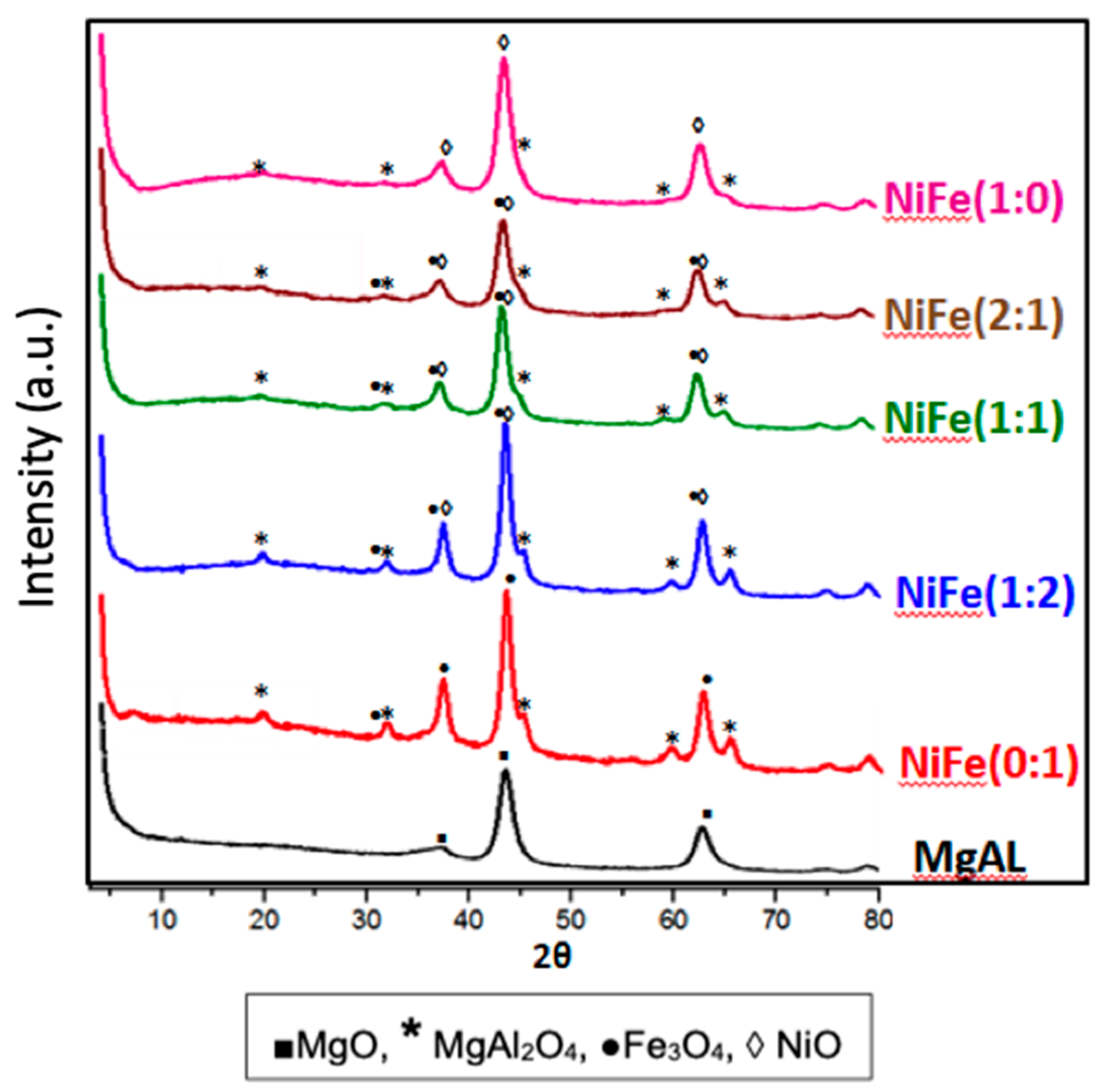
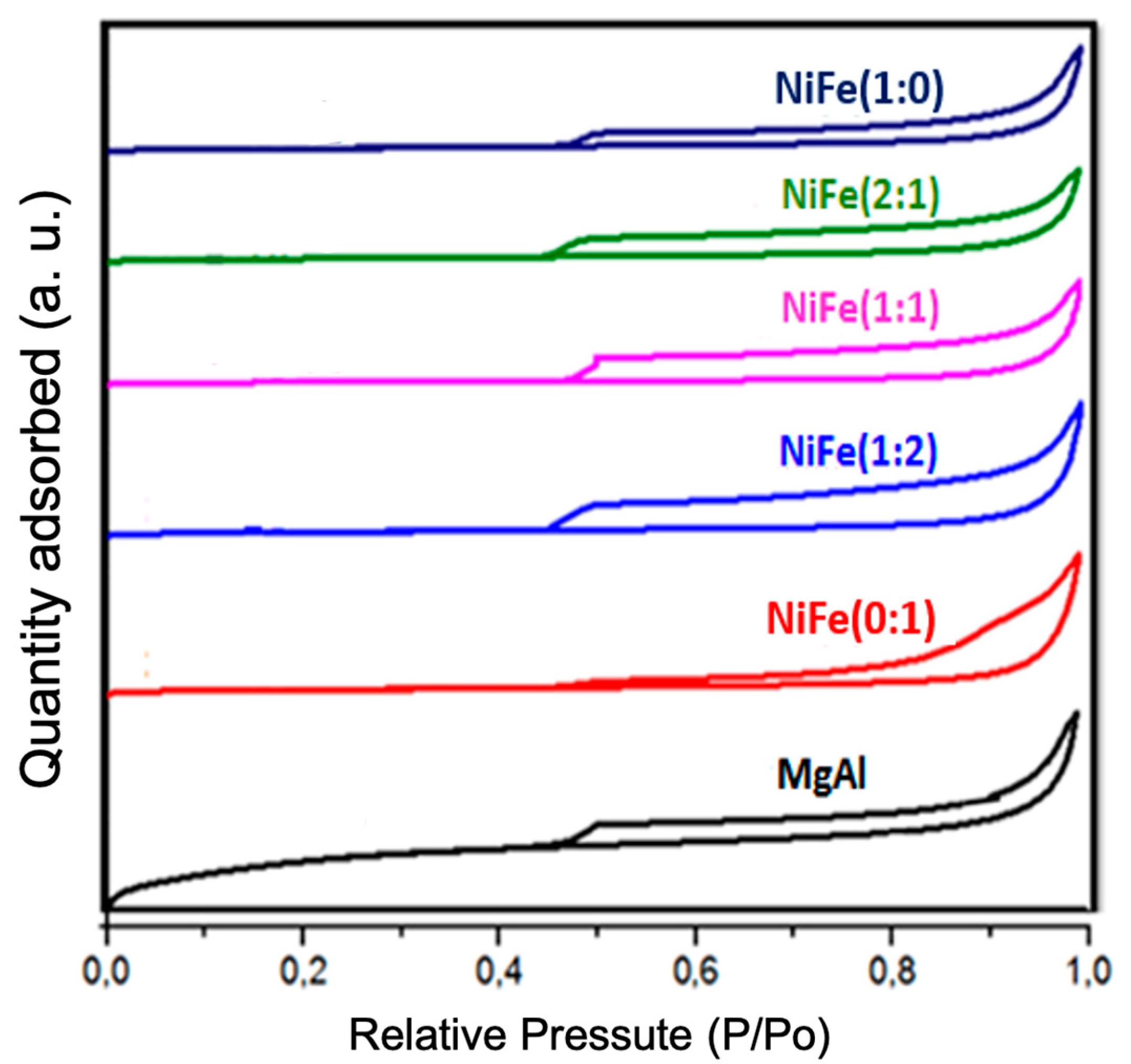
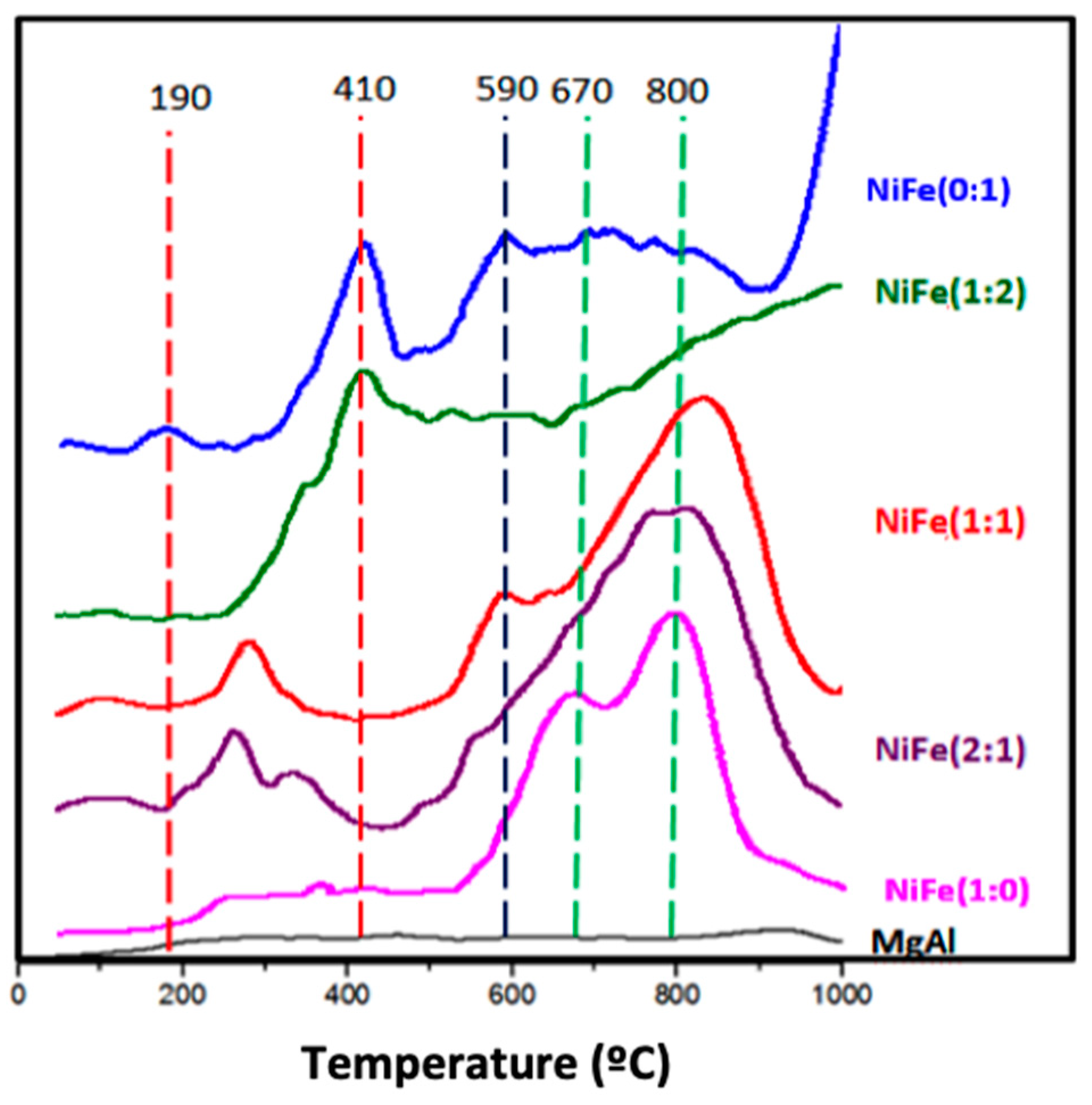
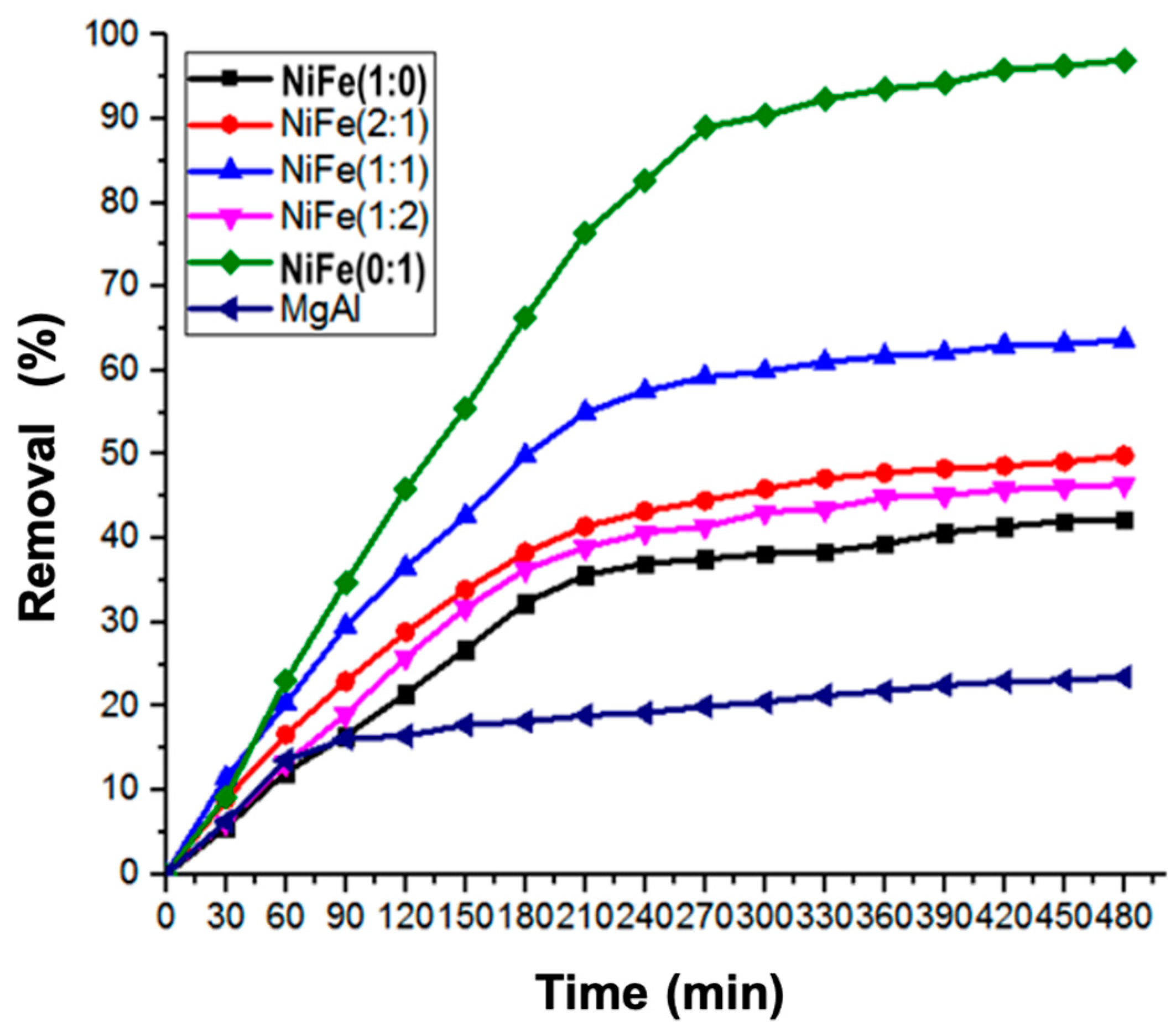
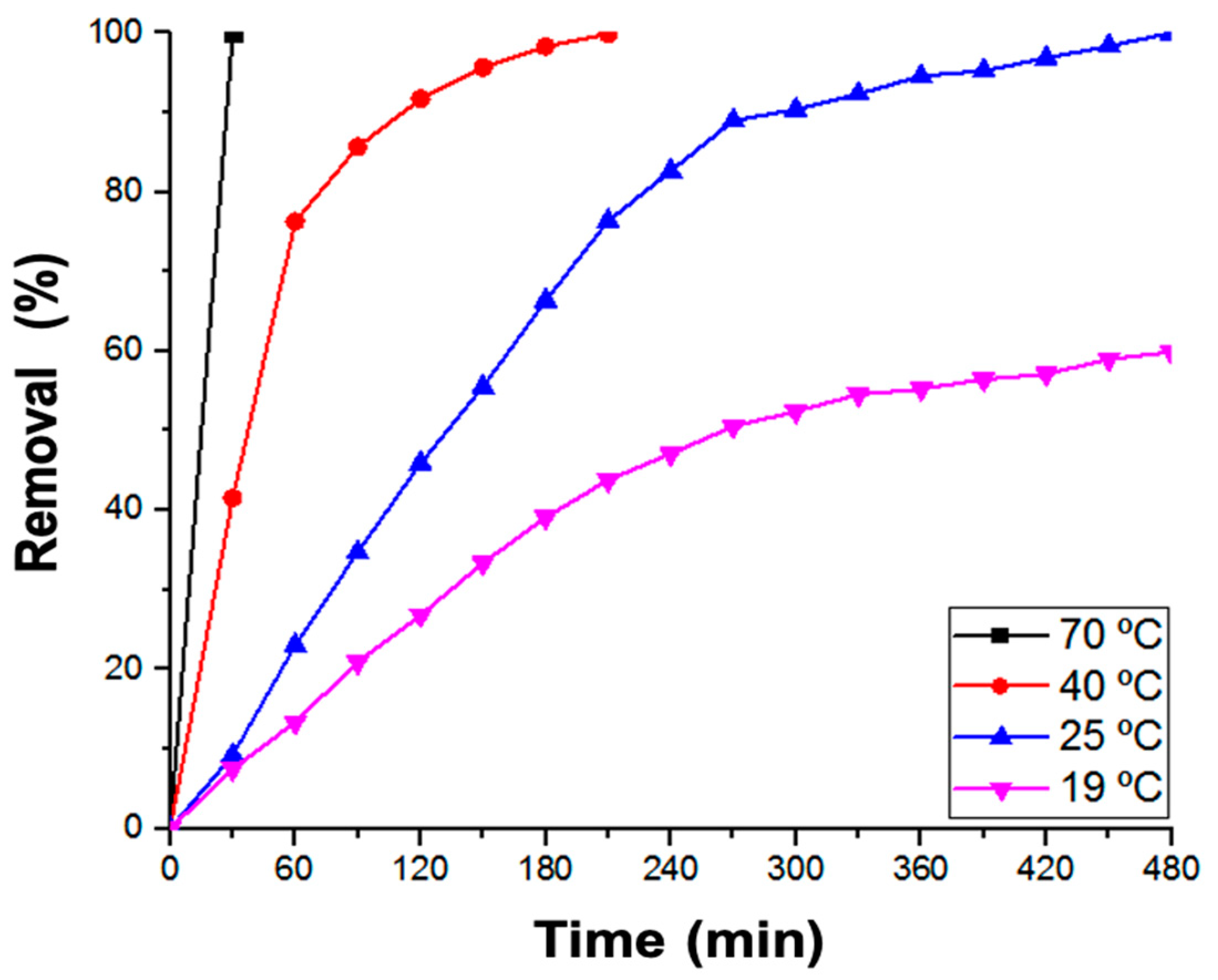
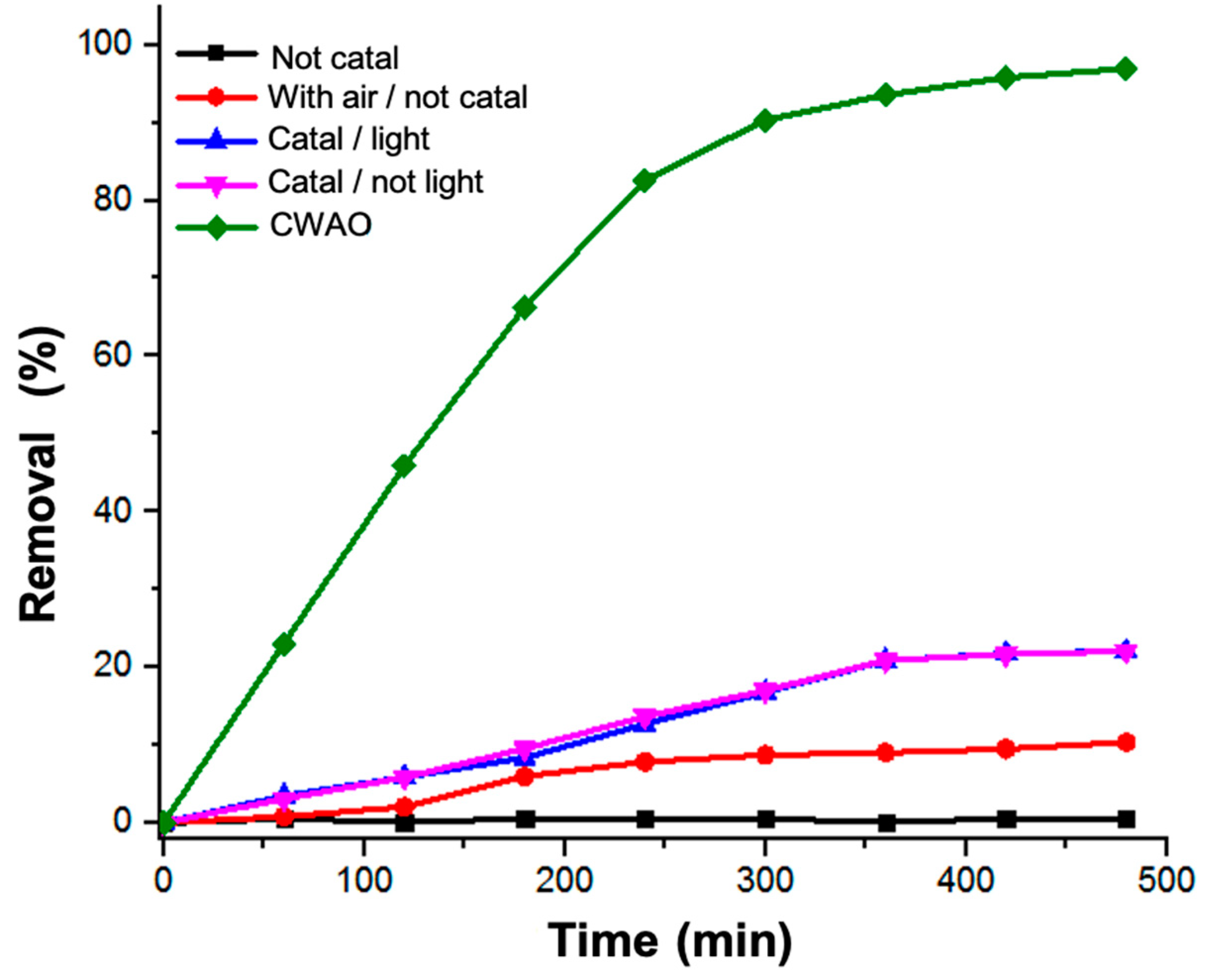
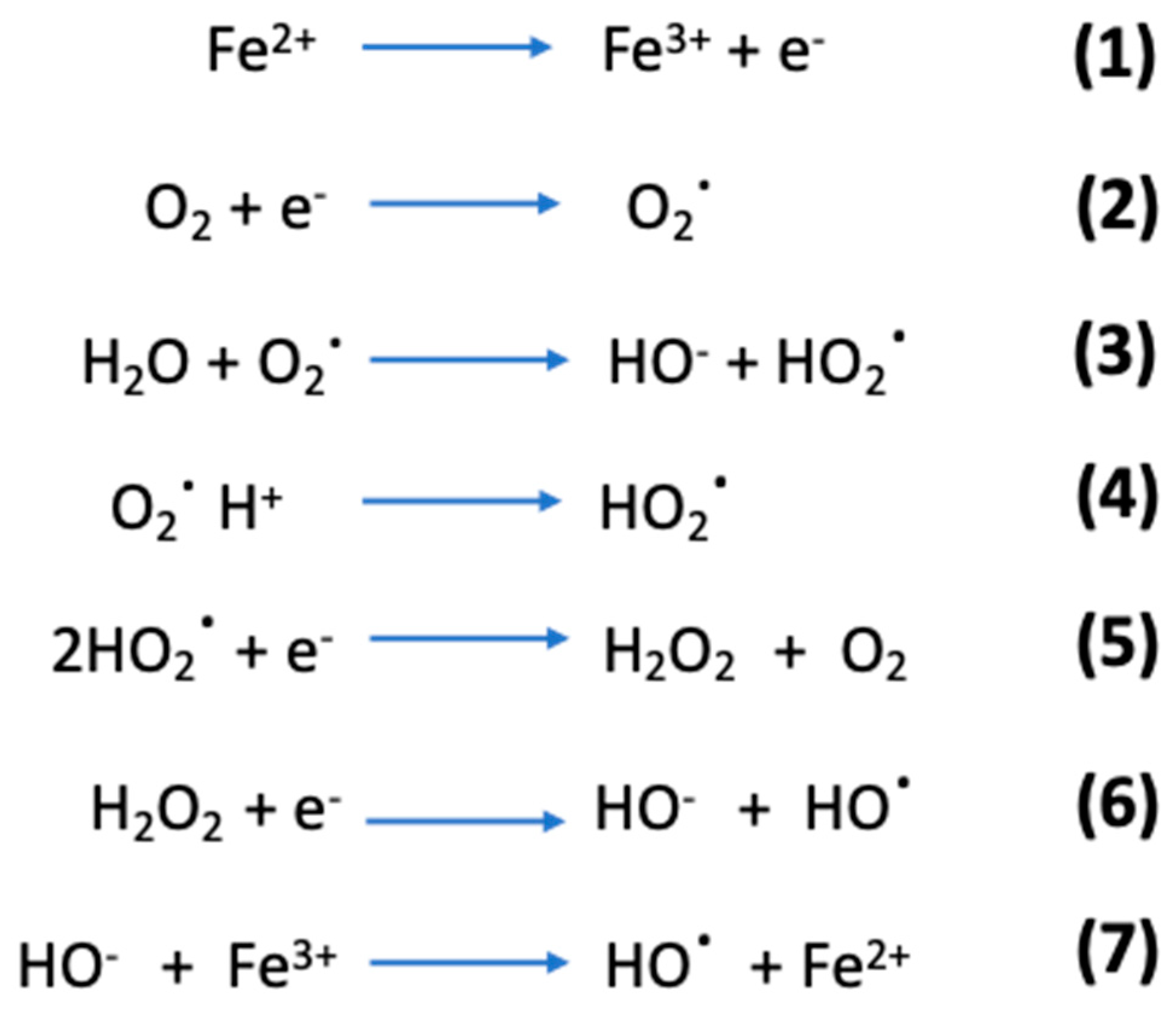
| Catalyst | SBET | Pore Volume (cm3 g−1) | FMWHFe | τ Fe (nm) | FMWHNi | τ Ni (nm) |
|---|---|---|---|---|---|---|
| MgAl | 211 | 0.286 | - | - | - | - |
| NiFe (0:1) | 85 | 0.180 | 0.703 | 3 | ||
| NiFe (1:2) | 80 | 0.171 | 0.624 | 4 | 0.699 | 2 |
| NiFe (1:1) | 70 | 0.135 | 0.779 | 3 | 0.739 | 2 |
| NiFe (2:1) | 75 | 0.120 | 0.748 | 3 | 0,532 | 3 |
| NiFe (1:0) | 75 | 0.136 | 0.592 | 2 |
| Solid | Temperature of High Reduction (°C) | Reducibility (%) | Ni/Al | Ratios Fe/Al | Mg/Al |
|---|---|---|---|---|---|
| NiFe (0:1) | 190 y 410 | 95 | - | 0.4 | 1.8 |
| NiFe (1:2) | 410 | 46 | 0.1 | 0.3 | 1.8 |
| NiFe (1:1) | 270, 590 y 850 | 78 | 0.2 | 0.2 | 1.7 |
| NiFe (2:1) | 250 y 850 | 48 | 0.3 | 0.1 | 1.8 |
| NiFe (1:0) | 670 y 820 | 46 | 0.4 | - | 1.8 |
| Catalyst | Elimination (%) | TOC (%) | DQO (%) |
|---|---|---|---|
| MgAl | 20 | 9 | 0 |
| NiFe (0:1) | 100 | 68 | 60 |
| NiFe (1:2) | 44 | 29 | 13 |
| NiFe (1:1) | 60 | 61 | 28 |
| NiFe (2:1) | 50 | 30 | 26 |
| NiFe (1:0) | 42 | 29 | 13 |
| Time (h) | NiFe (0:1) | NiFe (1:1) | NiFe (1:2)—NiFe (2:1)—NiFe (1:0) |
|---|---|---|---|
| 0 | CV | ||
| 2 | Ethylbenzene, p, m and o-xylene | ||
| 4 | Propylamine 1,2-diethoxyethane Aminoacetidrazide | Isobutylcyclopentane Dipropylene glycol Toluene | 1,1-diethoxyethane 1,3-dioxolane 2-hidroxypropyl ether butylamine |
| 6 | 2-hexanol 3-nitropropionic acid 1,1-diethoxyethane Carbon dioxide | 1-Chloro-2,3-epoxypropane Acetylmethylamine | 3-hexenylbutyrate dibutyl oxalate 1,3-dimethyl urea 2-heptenal |
| 8 | 4-amino-1-butanol 2-Methyl-2-butanol Propylamine | Oxirane 1-Methoxy-2-methyl -2-propanol | 2-isobutyl-2-propenol aminoacetonitrile propionamide n-methylacetidine 3-aminopropene |
© 2020 by the authors. Licensee MDPI, Basel, Switzerland. This article is an open access article distributed under the terms and conditions of the Creative Commons Attribution (CC BY) license (http://creativecommons.org/licenses/by/4.0/).
Share and Cite
Archila, K.; Campos, A.M.; Lugo, L.; Celis, C.A.; Moreno, S.; Reina, T.R.; Pérez-Flórez, A. Influence of the Active Phase (Fe, Ni, and Ni–Fe) of Mixed Oxides in CWAO of Crystal Violet. Catalysts 2020, 10, 1053. https://doi.org/10.3390/catal10091053
Archila K, Campos AM, Lugo L, Celis CA, Moreno S, Reina TR, Pérez-Flórez A. Influence of the Active Phase (Fe, Ni, and Ni–Fe) of Mixed Oxides in CWAO of Crystal Violet. Catalysts. 2020; 10(9):1053. https://doi.org/10.3390/catal10091053
Chicago/Turabian StyleArchila, Katherine, Ana María Campos, Lorena Lugo, Crispín Astolfo Celis, Sonia Moreno, Tomas Ramirez Reina, and Alejandro Pérez-Flórez. 2020. "Influence of the Active Phase (Fe, Ni, and Ni–Fe) of Mixed Oxides in CWAO of Crystal Violet" Catalysts 10, no. 9: 1053. https://doi.org/10.3390/catal10091053
APA StyleArchila, K., Campos, A. M., Lugo, L., Celis, C. A., Moreno, S., Reina, T. R., & Pérez-Flórez, A. (2020). Influence of the Active Phase (Fe, Ni, and Ni–Fe) of Mixed Oxides in CWAO of Crystal Violet. Catalysts, 10(9), 1053. https://doi.org/10.3390/catal10091053





